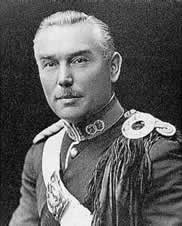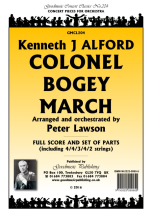Colonel Bogey March
Buy this item (in stock)
Product ID: GM1 CL204
By Kenneth Alford
Publisher:
Goodmusic
Arranger:
2 Flutes (2nd db.piccolo), 2 Oboes, 2 Clarinets in Bb, 2 Bassoons, 4 Horns in F, 2 Trumpets in Bb, 3 Trombones, Tuba, Timpani, Percussion (4 players: Snare Drum, Triangle, Cymbals (clashed), Tam-tam, Sleigh Bells, Tambourine, Bass Drum, Glockenspiel,
Series:
Goodmusic Concert Classics
Genre:
March
Line Up:
Symphony Orchestra
Duration:
4:30
Level: 3
Set & Score
This item is in stock
About this item
Colonel Bogey is a march written in 1914 by Lieutenant F. J. Ricketts (1881-1945), a British Army bandmaster who later became the director of music for the Royal Marines at Plymouth. He wrote under the pseudonym Kenneth J. Alford as service personnel at that time were not encouraged to have a life outside the military. Supposedly, the tune was inspired by a military man and golfer who whistled a characteristic two-note phrase instead of shouting "Fore!". It is this descending interval that begins each line of the melody. The name "Colonel Bogey" began in the later 19th century as the imaginary standard opponent; Edwardian golfers on both sides of the Atlantic often played matches against "Colonel Bogey". Bogey is now a golfing term meaning "one over par". The sheet music was a million-seller, and the march was recorded many times. At the start of World War II, "Colonel Bogey" became part of British way of life when the tune was used for the popular lyrics: "Hitler Has Only Got One Ball".
Instrumentation
2 Flutes (2nd db.piccolo), 2 Oboes, 2 Clarinets in Bb, 2 Bassoons, 4 Horns in F, 2 Trumpets in Bb, 3 Trombones, Tuba, Timpani, Percussion (4 players: Snare Drum, Triangle, Cymbals (clashed), Tam-tam, Sleigh Bells, Tambourine, Bass Drum, Glockenspiel, Tubular Bells), Harp (or Keyboard)
Strings (Violin 1, Violin 2, Viola, Cello, Bass)
Reviews and rating
No review available, be the first to write one!

Composer
Kenneth Alford (1881-1945)

Frederick Joseph Ricketts (21 February 1881 – 15 May 1945) was a British composer of marches for band. Using the pen name Kenneth J. Alford, his marches are considered to be great examples of the art. Where military music is performed, whether the venue be the historic Horse Guards Parade in London, the forecourt of the futuristic Opera House in Sydney, Australia, or, less grandly, the parade ground of a run-of-the-mill military establishment, almost certainly a march from the pen of Kenneth J. Alford will be performed. His career as a Bandmaster in the British Army and latterly as a Director of Music in the Royal Marines is legendary, and conductors, musicians and the public, are one with conductor Sir Vivian Dunn in calling Ricketts "The British March King." Ricketts’ frequent use of the saxophone contributed to its permanent inclusion in military bands.
More info about the composer...



 Click above to view samples
Click above to view samples
